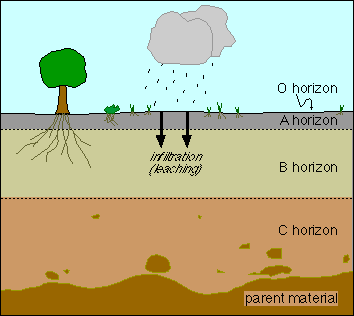
Weathering
Mechanical: Frost Wedging, unloading, salt crystal growth, stream abrasion, sand blasting, root wedging
Chemical: Acidification of water, hydrolysis of silicate minerals, dissolution of carbonate minerals (calcite-limestone) and some silicates, oxidation of iron cations, chelation of metal cations by organic compounds
Weathering Products:
For detailed discussion of weathering click on Weathering
Soils
Soil is a mixture of mineral matter produced by the weathering of bedrock or other parent material (e.g., glacial till) and organic matter supplied by plant growth. These materials are modified by continued weathering, downward leaching via infiltrating rainwater, and mixing via animal burrowing.
Soil Forming Processes:
1) physical and chemical weathering of parent material
2) incorporation of organic matter
3) downward leaching of fine particles and soluble ions
typical soil profile in temperate climate
O horizon: 100% organic (leaf litter, etc.)
A horizon: organic rich, depleted in fines and soluble ions
B horizon: organic poor, enriched in fines and soluble ions
C horizon: physically and chemically weathered parent material
the C horizon grades down into unaltered parent material
Soil Formation is affected by 6 factors
1) climate
2) vegetation
3) soil organisms
4) parent material
5) topography
6) time
Soil Classification
- Climate Classification (soil scientists)
based on differences in soil profiles developed in different climate conditions
Tropical - Equatorial: hot and wet: Pedalfers = Laterite
severe chemical weathering and leaching; even silica dissolved and leached
laterite residue = aluminim and iron hydroxides (bauxite and goethite)
soil profile is very deep but is very poor in nutrientsDesert Belts: hot and dry: Pedocals
poorly developed soil profiles because little organic matter and downward leaching
caliche (calcite rich) soil horizon develops due to evaporation of soil moistureTemperate mid-Latitude: warm-cool, moderate rainfall: Podzol
typical A, B, C soil horizonsPolar: cold and dry
little or no soil development because little vegetation and leaching; permafrost
much frost wedging-mechanical weathering, little chemical weathering